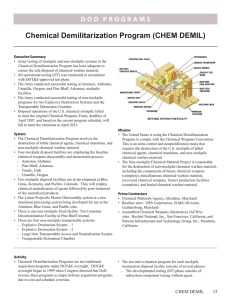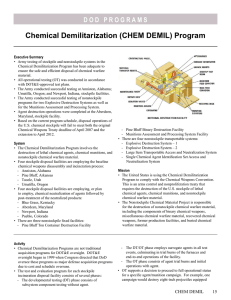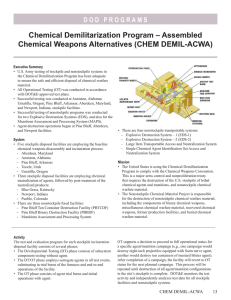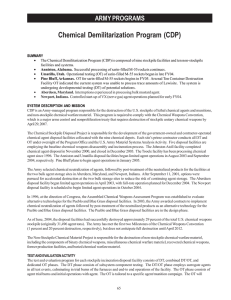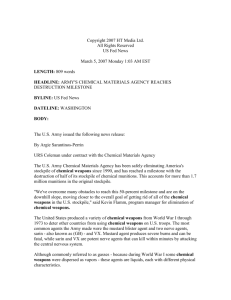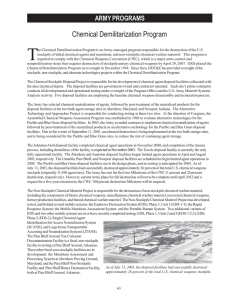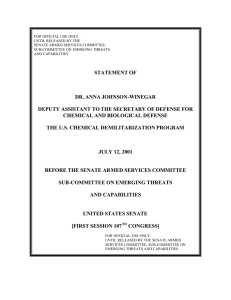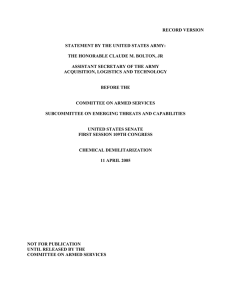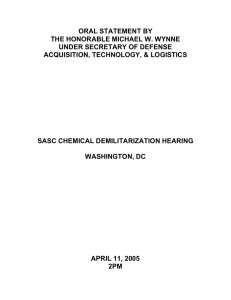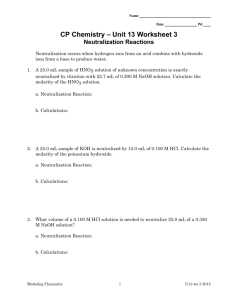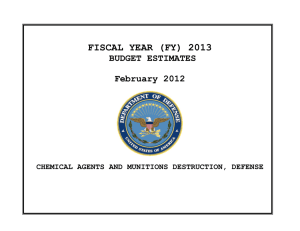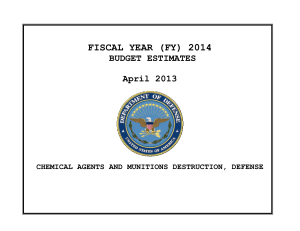Chemical Demilitarization Program (CHEM DEMIL)
advertisement
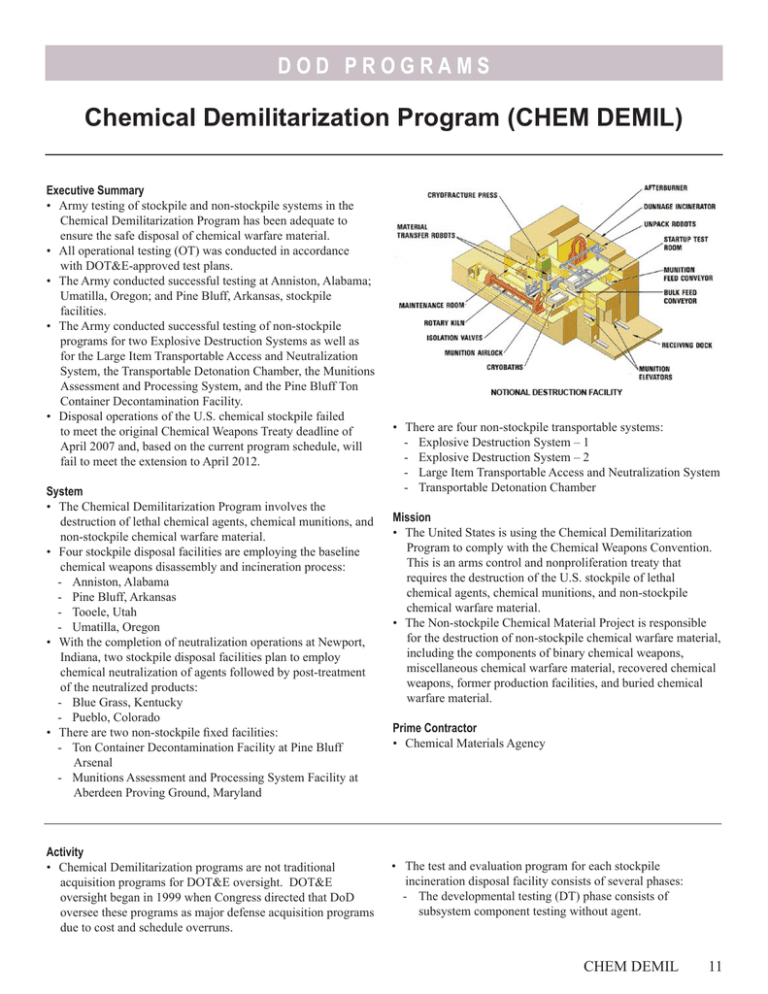
DOD P RO G R A M S Chemical Demilitarization Program (CHEM DEMIL) Executive Summary • Army testing of stockpile and non-stockpile systems in the Chemical Demilitarization Program has been adequate to ensure the safe disposal of chemical warfare material. • All operational testing (OT) was conducted in accordance with DOT&E-approved test plans. • The Army conducted successful testing at Anniston, Alabama; Umatilla, Oregon; and Pine Bluff, Arkansas, stockpile facilities. • The Army conducted successful testing of non-stockpile programs for two Explosive Destruction Systems as well as for the Large Item Transportable Access and Neutralization System, the Transportable Detonation Chamber, the Munitions Assessment and Processing System, and the Pine Bluff Ton Container Decontamination Facility. • Disposal operations of the U.S. chemical stockpile failed to meet the original Chemical Weapons Treaty deadline of April 2007 and, based on the current program schedule, will fail to meet the extension to April 2012. System • The Chemical Demilitarization Program involves the destruction of lethal chemical agents, chemical munitions, and non-stockpile chemical warfare material. • Four stockpile disposal facilities are employing the baseline chemical weapons disassembly and incineration process: - Anniston, Alabama - Pine Bluff, Arkansas - Tooele, Utah - Umatilla, Oregon • With the completion of neutralization operations at Newport, Indiana, two stockpile disposal facilities plan to employ chemical neutralization of agents followed by post-treatment of the neutralized products: - Blue Grass, Kentucky - Pueblo, Colorado • There are two non-stockpile fixed facilities: - Ton Container Decontamination Facility at Pine Bluff Arsenal - Munitions Assessment and Processing System Facility at Aberdeen Proving Ground, Maryland Activity • Chemical Demilitarization programs are not traditional acquisition programs for DOT&E oversight. DOT&E oversight began in 1999 when Congress directed that DoD oversee these programs as major defense acquisition programs due to cost and schedule overruns. • There are four non-stockpile transportable systems: - Explosive Destruction System – 1 - Explosive Destruction System – 2 - Large Item Transportable Access and Neutralization System - Transportable Detonation Chamber Mission • The United States is using the Chemical Demilitarization Program to comply with the Chemical Weapons Convention. This is an arms control and nonproliferation treaty that requires the destruction of the U.S. stockpile of lethal chemical agents, chemical munitions, and non-stockpile chemical warfare material. • The Non-stockpile Chemical Material Project is responsible for the destruction of non-stockpile chemical warfare material, including the components of binary chemical weapons, miscellaneous chemical warfare material, recovered chemical weapons, former production facilities, and buried chemical warfare material. Prime Contractor • Chemical Materials Agency • The test and evaluation program for each stockpile incineration disposal facility consists of several phases: - The developmental testing (DT) phase consists of subsystem component testing without agent. CHEM DEMIL 11 DOD P RO G R A M S - The DT/OT phase employs surrogate agents in all test events, culminating in trial burns of the furnaces and end-to-end operations of the facility. - The OT phase consists of agent trial burns and initial operations with agent. • OT supports a decision to proceed to full operational status for a specific agent/munition campaign. For example, one campaign would destroy 8-inch projectiles equipped with Sarin nerve agent, another would destroy M55 rockets with Sarin, and a third would destroy 1-ton containers of mustard blister agent. After completion of each campaign, the facility reverts to OT status for the next planned campaign. This process is repeated until destruction of all agent/munition configurations in the site’s stockpile is complete. DOT&E monitors the test activity and independently analyzes test data for all stockpile facilities and non-stockpile systems. • The Newport, Indiana, stockpile disposal facility completed VX neutralization and ton container processing and transitioned to closure activities. • As of August 5, 2008, approximately 56 percent of the total U.S. chemical weapons stockpile (originally 31,498 agent tons) had been destroyed. FY08 test activity for stockpile facilities and non-stockpile systems is summarized in Table 1. Assessment • Army testing of stockpile and non-stockpile systems in the Chemical Demilitarization Program has been adequate to ensure the safe disposal of chemical warfare material. The U.S. Army Material Systems Analysis Activity is providing effective independent oversight of the testing of both stockpile and non-stockpile programs. Their expertise and vigilance has resulted in early identification and resolution of problems as they occur. Fully integrated operational demonstrations that confirm all phases of operations (including preparation, destruction/neutralization, and disposal) remain critical prerequisites before transition to operations with live agents. • Disposal operations of the U.S. chemical stockpile failed to meet the original Chemical Weapons Treaty deadline of April 2007 and, based on the current program schedule, will fail to meet the extension to April 2012. Recommendations • Status of Previous Recommendations. There were no FY07 recommendations for the Chemical Demilitarization Program. • FY08 Recommendations. None. Table 1. Chemical Demilitarization Test and Evaluation Activity Facility/System Technology FY08 Activity Agent Tested Planned FY09 Activity Anniston Incineration OT OT Umatilla Incineration OT Pine Bluff Incineration Newport Neutralization OT Operations Closure Activities Explosive Destruction System Version 1 Neutralization DT/OT Neutralization OT Neutralization OT Transportable Detonation Chamber Thermal Decomposition DT/OT FOT&E VX M23 Land Mines VX M55 Rockets VX 155 mm Projectiles VX 6-inch Projectiles VX M23 Land Mines VX Neutralization and Ton Container Processing Chloroacetophenone (a.k.a. CNS, CNB) 75 mm Projectiles Phosgene (a.k.a. CG) 4.2-inch Mortar and 75 mm Projectile (simultaneous) Arsenicals German Traktor Rockets Mustard (a.k.a. HD) M70/M47 Bombs Phosgene (a.k.a. CG) M-78 500-pound bomb M-79 1,000-pound bomb (simulated munitions) Phosgene (a.k.a. CG) 155 mm, 75 mm Projectiles and 4.2-inch Mortars (recovered) Chloropicrin (a.k.a. PS) one Mortar Round Munitions Assessment and Processing System Neutralization OT Phosgene (a.k.a. CG) 75 mm Projectiles (recovered) Testing Suspended (recovered munitions unavailable) Pine Bluff Ton Container Decontamination Facility Magnetic Induction Heating DT/OT Trace Agents during Ton Container Processing FOT&E Explosive Destruction System Version 2 Large Item Transportable Access and Neutralization System 12 CHEM DEMIL OT OT Closure Activities OT OT OT DT/OT
